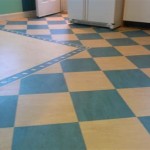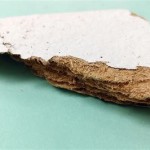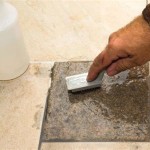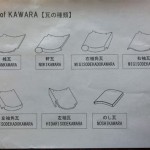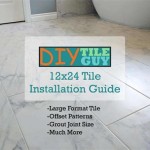How To Remove Tile Glue From Concrete Slab
Removing tile adhesive, commonly referred to as tile glue or thin-set mortar, from a concrete slab is a common task in renovation projects. The process can be labor-intensive, but proper preparation and the correct techniques can make it significantly more manageable. This article will outline the steps involved in removing tile adhesive from a concrete slab, providing a comprehensive guide for both DIY enthusiasts and professionals.
Understanding the Nature of Tile Adhesive
Tile adhesive is designed to create a strong bond between the tile and the subfloor, which, in many cases, is a concrete slab. Its composition typically includes cement, fine aggregates, polymers, and additives that enhance its adhesion, flexibility, and water resistance. The strength of the bond makes removing the adhesive challenging, especially if it's been in place for an extended period. Understanding the adhesive’s properties is crucial in selecting the most effective removal method.
Different types of tile adhesive exist, each with varying bond strengths and compositions. Modified thin-set mortars, for example, contain polymers that enhance adhesion and flexibility, making them more difficult to remove compared to unmodified mortars. Furthermore, the age of the adhesive plays a significant role in its tenacity. Older adhesives may have hardened and become more brittle, while newer adhesives may still retain some flexibility.
The condition of the concrete slab also influences the removal process. A smooth, well-prepared concrete surface provides a better bonding surface for the adhesive, increasing the difficulty of removal. Conversely, a porous or uneven surface may allow for easier removal in some areas, but more challenging removal in others where the adhesive has penetrated deeper into the concrete.
Preparation is Key
Before initiating the removal process, thorough preparation is essential. This involves gathering the necessary tools and equipment, ensuring a safe working environment, and protecting surrounding areas from dust and debris.
Tools and Materials: The required tools typically include a scraper (either a manual floor scraper or a powered scraper), a hammer, a chisel, safety glasses, a dust mask or respirator, work gloves, a shop vacuum, and potentially a chemical adhesive remover. A floor grinder with a diamond grinding wheel may also be necessary for removing stubborn adhesive residue. The choice of tools will depend on the type and thickness of the adhesive, as well as the size of the area.
Safety Precautions: Safety is paramount when removing tile adhesive. Concrete dust and adhesive particles can be harmful if inhaled or come into contact with the eyes. Therefore, wearing safety glasses, a dust mask or respirator, and work gloves is non-negotiable. Adequate ventilation is also crucial, especially when using chemical adhesive removers. These removers can release harmful fumes, so working in a well-ventilated area or using a respirator with appropriate cartridges is essential.
Protecting Surrounding Areas: Removing tile adhesive can generate a substantial amount of dust and debris. Protecting surrounding areas with plastic sheeting or drop cloths is crucial to prevent contamination and simplify cleanup. Covering doorways and air vents can help contain the dust within the work area. Additionally, removing any furniture or valuables from the area will prevent damage and facilitate easier movement.
Methods for Removing Tile Adhesive
Several methods can be employed to remove tile adhesive from a concrete slab, each with its advantages and disadvantages. The choice of method will depend on factors such as the type and thickness of the adhesive, the size of the area, and the available tools and resources.
Manual Scraping: Manual scraping involves using a hand scraper or a chisel and hammer to chip away at the adhesive. This method is best suited for small areas or for removing loose adhesive. It's a relatively low-cost option, but it can be time-consuming and physically demanding, especially for large areas with a thick layer of adhesive.
To effectively use a hand scraper, hold the scraper at a low angle to the concrete surface and apply consistent pressure. For stubborn areas, use a hammer and chisel to break the adhesive into smaller, more manageable pieces. Be careful not to gouge or damage the concrete slab while scraping. Regularly sharpen the scraper blade to maintain its effectiveness.
Powered Scraping: Powered scrapers, also known as floor scrapers or demolition hammers, are electric or pneumatic tools designed to remove flooring materials, including tile adhesive. These tools are more efficient than manual scraping, especially for large areas and thicker adhesive layers. However, they can be more expensive to rent or purchase.
When using a powered scraper, select the appropriate blade for the type of adhesive being removed. Start by positioning the scraper blade at a low angle to the concrete surface and apply gentle pressure. Gradually increase the pressure as needed to remove the adhesive. Move the scraper in a consistent, overlapping pattern to ensure even removal. Be mindful of the potential for dust generation and wear appropriate safety gear.
Chemical Adhesive Removers: Chemical adhesive removers are solvents designed to soften or dissolve tile adhesive, making it easier to scrape away. These removers are available in various formulations, each targeting specific types of adhesive. When selecting a chemical remover, read the product label carefully to ensure it's compatible with the type of adhesive being removed and the concrete slab. It is very important to understand the hazards, proper PPE and ventilation requirements of the chemical adhesive remover being used.
Apply the chemical remover according to the manufacturer's instructions. Typically, this involves applying a generous layer of the remover to the adhesive surface and allowing it to dwell for a specified period. The dwell time allows the remover to penetrate and soften the adhesive. After the dwell time, use a scraper to remove the softened adhesive. Multiple applications may be necessary for thick or stubborn adhesive layers.
Floor Grinding: Floor grinding involves using a floor grinder equipped with a diamond grinding wheel to abrade the adhesive surface. This method is particularly effective for removing thin layers of adhesive residue or for smoothing out uneven concrete surfaces after other removal methods have been used. However, floor grinding can generate a significant amount of dust and requires specialized equipment.
When using a floor grinder, select the appropriate grinding wheel for the type of adhesive and concrete surface. Start with a coarse grit wheel to remove the bulk of the adhesive and then switch to a finer grit wheel to smooth the surface. Move the grinder in a consistent, overlapping pattern to ensure even removal. Use a vacuum attachment to collect dust as it's generated. Be mindful of the potential for overheating the grinding wheel and damaging the concrete surface.
Addressing Stubborn Adhesive Residue
After the initial removal process, some adhesive residue may remain on the concrete slab. Addressing this residue is crucial to ensure a clean and smooth surface for subsequent flooring installations. Several techniques can be used to remove stubborn adhesive residue.
A hand scraper can be used to remove small patches of remaining adhesive. A wire brush, either manual or powered, can be effective for scrubbing away thin layers of adhesive residue. For larger areas, a chemical adhesive remover can be applied to soften the residue before scraping. Floor grinding can also be used to smooth out the surface and remove any remaining residue.
It's important to thoroughly clean the concrete slab after removing the adhesive residue. Use a shop vacuum to remove any dust and debris. Then, wash the surface with a mild detergent and water to remove any remaining chemical residue. Allow the concrete slab to dry completely before proceeding with any further flooring installations.
Ensuring a level substrate is essential for many flooring types. Some leveling compounds may not bond well with residual adhesive, even thin layers. This can result in flooring failing after installation and often requires costly repairs. It is often recommended to remove all residual adhesive before proceeding with any self-leveling.

How To Remove Old Floor Tile Adhesive All Stripped

How To Remove Adhesive From Concrete Floors 5 Diy Ways Get Glue Off

How To Remove Tile Adhesive Maid2match

Best Ways To Take Out Even Impossible Remove Glue From Floors

How To Remove Tile Glue From Concrete Stone Protection

How To Remove Tile Adhesive Maid2match

How To Remove Carpet Glue From Concrete 4 Proven Ways Network

How To Remove Black Mastic Or Carpet Glue From A Concrete Floor Www Sealgreen Com 800 997 3873

How To Remove Adhesive From Concrete Floors 5 Diy Ways Get Glue Off

The Best Way To Remove Thinset From Concrete House Home
Related Posts

